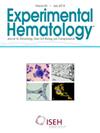大规模中介孟德尔随机化分析确定了多种免疫细胞介导肠道微生物和慢性移植物抗宿主病风险之间的因果关系。
IF 2.1
4区 医学
Q2 HEMATOLOGY
引用次数: 0
摘要
目的:已经观察到肠道微生物群和免疫细胞的紊乱参与了不相关hla匹配供体移植后慢性移植物抗宿主病(cGVHD)的发生,但它们之间的因果关系尚未完全清楚。方法:研究采用孟德尔随机化(MR),整合来自MiBioGen联盟(微生物分类群)、SardiNIA项目(免疫性状)和FHCRC队列疾病数据的全基因组关联研究(GWAS)荟萃分析,研究它们之间的复杂关系。目的是探讨特定肠道微生物群和免疫性状对cGVHD发病率的因果关系,采用中介分析来确定哪些免疫性状可能介导微生物群对这种疾病的影响。结果:经多次检测调整,主分析发现3个特异性微生物类群与cGVHD有显著的因果关系:Lactococcus.id.1851(OR = 1.989,95% CI = 1.311 ~ 3.019,P = 0.001),Ruminiclostridium9.id.11357(OR = 3.273,95% CI = 1.604 ~ 6.679,P = 0.001),和ntestinimonas.id.2062(or = 0.400,95% ci = 0.230 ~ 0.697,p = 0.001)。复杂敏感性分析和多变量MR分析排除了可能的水平多效性和偏倚。此外,经过多次测试调整,10种免疫特性(FDR q < 0.1)被确定为影响cGVHD风险,主要包括treg和B细胞。两步介导MR分析显示了鉴定的微生物分类群对Tregs和B细胞的影响,并详细说明了n肠系菌通过CD27影响cGVHD对记忆B细胞的途径(比例介导 = 4.2%)。同样,Ruminiclostridium9与效应记忆双阴性(emdn;CD4- CD8-) T细胞介导cGVHD,占总效应的9.5%。结论:这项MR研究强调了cGVHD发展中特定微生物群和免疫细胞之间的关键相互作用,为潜在的治疗靶点和疾病管理途径提供了见解。本文章由计算机程序翻译,如有差异,请以英文原文为准。
Large-scale mediator Mendelian randomization analysis identifies multiple immune cells mediating the causal link between gut microbes and chronic graft-versus-host disease risk
Disorders of gut microbiota and immune cells have been observed to be involved in the occurrence of chronic graft-versus-host disease (cGVHD), but their causal connections have yet to be fully understood. This study utilized Mendelian randomization (MR), integrating genome-wide association study (GWAS) meta-analyses from the MiBioGen consortium (microbial taxa), the SardiNIA project (immune traits), and disease data from the Fred Hutchinson Cancer Research Center (FHCRC) cohort to investigate their relationships. The aim was to explore the causal effects of microbiota and immune traits on the incidence of cGVHD, using mediation analysis to identify which immune traits might mediate the effects of microbiota on this condition. The main analysis observed significant causal associations of 3 specific microbial taxa with cGVHD: Lactococcus.id.1851 (odds ratio [OR] = 1.989, 95% confidence interval [CI] = 1.311–3.019, p = 0.001), Ruminiclostridium9.id.11357 (OR = 3.273, 95% CI = 1.604–6.679, p = 0.001), and Intestinimonas.id.2062 (OR = 0.400, 95% CI = 0.230–0.697, p = 0.001). Sensitivity analysis and multivariable MR analysis ruled out possible horizontal pleiotropy and bias. Additionally, 10 immune traits, predominantly covering regulatory T cells (Tregs) and B cells, were identified as influencing cGVHD risk. The two-step mediation MR analysis presented the effect of identified microbial taxa on Tregs and B cells and detailed the pathways through which Intestinimonas impacts cGVHD via CD27 on memory B cells (proportion mediated = 4.2%). Similarly, the role of interactions between Ruminiclostridium9 and effector memory double-negative T cells in mediating cGVHD was quantified, accounting for 9.5% of the total effect.
求助全文
通过发布文献求助,成功后即可免费获取论文全文。
去求助
来源期刊

Experimental hematology
医学-血液学
CiteScore
5.30
自引率
0.00%
发文量
84
审稿时长
58 days
期刊介绍:
Experimental Hematology publishes new findings, methodologies, reviews and perspectives in all areas of hematology and immune cell formation on a monthly basis that may include Special Issues on particular topics of current interest. The overall goal is to report new insights into how normal blood cells are produced, how their production is normally regulated, mechanisms that contribute to hematological diseases and new approaches to their treatment. Specific topics may include relevant developmental and aging processes, stem cell biology, analyses of intrinsic and extrinsic regulatory mechanisms, in vitro behavior of primary cells, clonal tracking, molecular and omics analyses, metabolism, epigenetics, bioengineering approaches, studies in model organisms, novel clinical observations, transplantation biology and new therapeutic avenues.
 求助内容:
求助内容: 应助结果提醒方式:
应助结果提醒方式:


